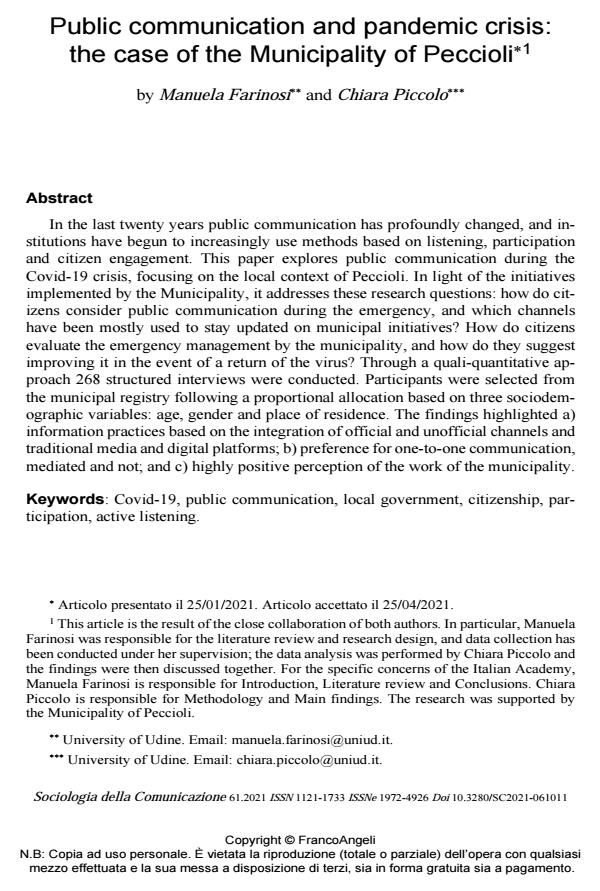Public communication and pandemic crisis: the case of the Municipality of Peccioli
Titolo Rivista SOCIOLOGIA DELLA COMUNICAZIONE
Autori/Curatori Manuela Farinosi, Chiara Piccolo
Anno di pubblicazione 2021 Fascicolo 2021/61 Lingua Inglese
Numero pagine 10 P. 159-168 Dimensione file 218 KB
DOI 10.3280/SC2021-061011
Il DOI è il codice a barre della proprietà intellettuale: per saperne di più
clicca qui
Qui sotto puoi vedere in anteprima la prima pagina di questo articolo.
Se questo articolo ti interessa, lo puoi acquistare (e scaricare in formato pdf) seguendo le facili indicazioni per acquistare il download credit. Acquista Download Credits per scaricare questo Articolo in formato PDF

FrancoAngeli è membro della Publishers International Linking Association, Inc (PILA)associazione indipendente e non profit per facilitare (attraverso i servizi tecnologici implementati da CrossRef.org) l’accesso degli studiosi ai contenuti digitali nelle pubblicazioni professionali e scientifiche
In the last twenty years public communication has profoundly changed, and institutions have begun to increasingly use methods based on listening, participa-tion and citizen engagement. This paper explores public communication during the Covid-19 crisis, focusing on the local context of Peccioli. In light of the initiatives implemented by the Municipality, it addresses these research questions: how do citizens consider public communication during the emergency, and which channels have been mostly used to stay updated on municipal initiatives? How do citizens evaluate the emergency management by the municipality, and how do they sug-gest improving it in the event of a return of the virus? Through a quali-quantitative approach 268 structured interviews were conducted. Participants were selected from the municipal registry following a proportional allocation based on three so-ciodemographic variables: age, gender and place of residence. The findings high-lighted a) information practices based on the integration of official and unofficial channels and traditional media and digital platforms; b) preference for one-to-one communication, mediated and not; and c) highly positive perception of the work of the municipality.
Keywords:Covid-19, public communication, local government, citizenship, par-ticipation, active listening.
- Voogd, H., Woltjer, J. (1999), The communicative ideology in spatial planning, in «Environment and Planning B» n. 26(6), pp. 835-854.
- Allegretti U. (2010), Democrazia Partecipativa: esperienze e prospettive in Italia e in Europa, Firenze University Press, Firenze.
- Arnstein S. R., (1969), A ladder of citizen participation, in «Journal of the American Institute of Planners» n. 35(4), pp. 216-224. DOI: 10.1080/01944366908977225
- Bobbio L., Pomatto G. (2007), Il coinvolgimento dei cittadini nelle scelte pubbliche, in «Meridiana» n. 58, pp. 45-67.
- Canel M.J., Luoma-aho V. (2018), Public Sector Communication. Closing Gaps Between Citizens and Public Organizations, Wiley, Hoboken.
- Caspretti S. (2013), La strategia del consenso nel caso della discarica di Peccioli, in «Partecipazione e Conflitto» n. 6(1), pp. 102-120. DOI: 10.3280/PACO2013-001006
- Ciaffi D., Mela A. (2006), La partecipazione, Carocci, Roma.
- Connor D. M. (1988), A new ladder of citizen participation, in «National Civic Review» n. 77(3), pp. 249-257.
- Creighton J. L. (2005), The public participation handbook: Making better decisions through citizen involvement, Jossey-Bass, San Francisco.
- Dahlgren P. (2009), Media and political engagement. Citizens, Communication and Democracy, Cambridge University Press, Cambridge.
- Doolittle A., Faul A.C. (2013), Civic engagement scale: A validation study, in «SAGE Open» n. 3(3), pp. 1-8. DOI: 10.1177/2158244013495542
- Ducci G. (2017), Relazionalità consapevole. La comunicazione pubblica nella società connessa, FrancoAngeli, Milano.
- Eurostat (2020). Urban and rural living in the EU, -- https://ec.europa.eu/eurostat/web/products-eurostat-news/-/EDN-20200207-1
- Farinosi M. (2019), Comunicazione e processi partecipativi. Amministrazione pubblica e coinvolgimento dei cittadini nel Comune di Peccioli, FrancoAngeli, Milano.
- Farinosi M., Fortunati L., O’Sullivan J., Pagani L. (2019), Enhancing classical methodological tools to foster participatory dimensions in local urban planning, in «Cities» n. 88, pp. 235-242.
- Gret M., Sintomer Y. (2002), Porto Alegre. L’espoir d’une autre démocratie, La Découverte, Paris.
- Schlossberg M., Shuford E. (2005), Delineating “public” and “participation” in PPGIS, in «URISA Journal» n. 16(2), URISA, pp. 15-26.
- Sclavi M. (2002), Avventure urbane. Progettare la città con gli abitanti, Eleuthera, Milano.
- Silverman D. (1997), Qualitative research: Theory, method and practice, Sage, London.
- Urbinati N. (2014), Democracy disfigured. Opinion, truth, and the people, Harvard University Press, Cambridge.
- Wilcox D. (1994), The guide to effective participation, Partnership Books, Brighton.
Manuela Farinosi, Chiara Piccolo, Public communication and pandemic crisis: the case of the Municipality of Peccioli in "SOCIOLOGIA DELLA COMUNICAZIONE " 61/2021, pp 159-168, DOI: 10.3280/SC2021-061011